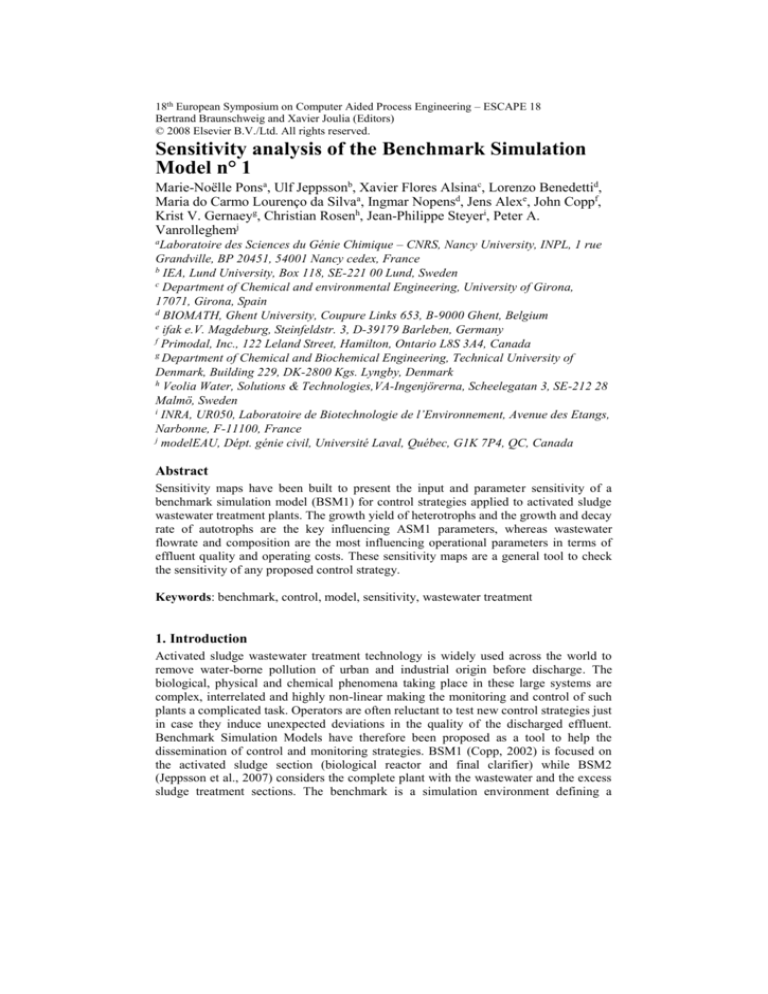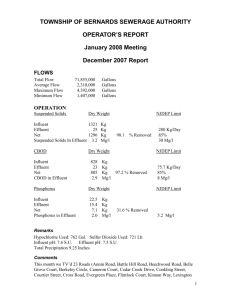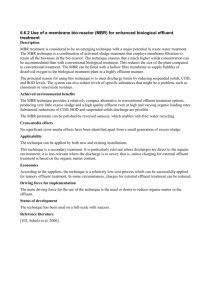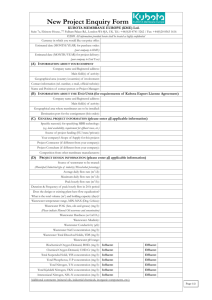
18th European Symposium on Computer Aided Process Engineering – ESCAPE 18
Bertrand Braunschweig and Xavier Joulia (Editors)
© 2008 Elsevier B.V./Ltd. All rights reserved.
Sensitivity analysis of the Benchmark Simulation
Model n° 1
Marie-Noëlle Ponsa, Ulf Jeppssonb, Xavier Flores Alsinac, Lorenzo Benedettid,
Maria do Carmo Lourenço da Silvaa, Ingmar Nopensd, Jens Alexe, John Coppf,
Krist V. Gernaeyg, Christian Rosenh, Jean-Philippe Steyeri, Peter A.
Vanrolleghemj
Laboratoire des Sciences du Génie Chimique – CNRS, Nancy University, INPL, 1 rue
Grandville, BP 20451, 54001 Nancy cedex, France
b
IEA, Lund University, Box 118, SE-221 00 Lund, Sweden
c
Department of Chemical and environmental Engineering, University of Girona,
17071, Girona, Spain
d
BIOMATH, Ghent University, Coupure Links 653, B-9000 Ghent, Belgium
e
ifak e.V. Magdeburg, Steinfeldstr. 3, D-39179 Barleben, Germany
f
Primodal, Inc., 122 Leland Street, Hamilton, Ontario L8S 3A4, Canada
g
Department of Chemical and Biochemical Engineering, Technical University of
Denmark, Building 229, DK-2800 Kgs. Lyngby, Denmark
h
Veolia Water, Solutions & Technologies,VA-Ingenjörerna, Scheelegatan 3, SE-212 28
Malmö, Sweden
i
INRA, UR050, Laboratoire de Biotechnologie de l’Environnement, Avenue des Etangs,
Narbonne, F-11100, France
j
modelEAU, Dépt. génie civil, Université Laval, Québec, G1K 7P4, QC, Canada
a
Abstract
Sensitivity maps have been built to present the input and parameter sensitivity of a
benchmark simulation model (BSM1) for control strategies applied to activated sludge
wastewater treatment plants. The growth yield of heterotrophs and the growth and decay
rate of autotrophs are the key influencing ASM1 parameters, whereas wastewater
flowrate and composition are the most influencing operational parameters in terms of
effluent quality and operating costs. These sensitivity maps are a general tool to check
the sensitivity of any proposed control strategy.
Keywords: benchmark, control, model, sensitivity, wastewater treatment
1. Introduction
Activated sludge wastewater treatment technology is widely used across the world to
remove water-borne pollution of urban and industrial origin before discharge. The
biological, physical and chemical phenomena taking place in these large systems are
complex, interrelated and highly non-linear making the monitoring and control of such
plants a complicated task. Operators are often reluctant to test new control strategies just
in case they induce unexpected deviations in the quality of the discharged effluent.
Benchmark Simulation Models have therefore been proposed as a tool to help the
dissemination of control and monitoring strategies. BSM1 (Copp, 2002) is focused on
the activated sludge section (biological reactor and final clarifier) while BSM2
(Jeppsson et al., 2007) considers the complete plant with the wastewater and the excess
sludge treatment sections. The benchmark is a simulation environment defining a
2
M.N. Pons et al.
realistic plant layout, a simulation model, influent loads, test procedures and evaluation
criteria.
It should be noted however that this performance is dependent on the assumptions made
in the model, such as hydraulics (Pons and Potier, 2004) as well as parameters (design,
model, operation, etc.). For a potential user, whose plant differs from the original BSM1
layout and/or operation conditions, it is useful to check the transferability of the
evaluation results, in other words, the sensitivity of the control performance with respect
to the design and operational parameters (Vanrolleghem & Gillot, 2002). The present
contribution deals with a sensitivity analysis of the activated sludge section (i.e. BSM1)
with respect to:
- design parameters (volumes of the biological reactor (Vt) and the clarifier
(Vclar), ratio of anoxic to total reactor volume (Va/Vt))
- model parameters (ASM1 model (Henze et al., 1987) in the biological reactor,
the Takács et al. (1991) model in the clarifier)
- operational parameters (external (Qa) and internal (Qr) recycle flow rates,
wastage flow rate (Qw), oxygen mass transfer coefficient (KLa))
- influent characteristics (dynamic variations in flow rate (Q0) and composition)
The analysis is conducted in open-loop, for steady-state and dynamic conditions. The
variations in performance criteria such as effluent quality and operational cost
(including aeration and pumping energy as well as sludge disposal) are visualized
through sensitivity maps.
2. Presentation of BSM1
2.1. Plant layout
The benchmark plant consists of a five-compartment nitrogen removing activated
sludge reactor consisting of two anoxic tanks followed by three aerobic tanks and a
secondary settler in a standard predenitrification configuration (Figure 1). All
information about BSM1 and its implementation can be found in Copp (2002).
To r iver
B iological reactor
Q 0, Z 0
Unit 1
Unit 2
Unit 3
Q e , Ze
C larifie r
W astewa ter
Unit 4
m = 10
Unit 5
kL a
PI
m=6
D isso lve d
ox yge n
A nox ic sec tion
N itra te
A era ted se ctio n
PI
k L a = o xyg en tr ans fer co efficien t
In tern al rec ycle
Q f, Zf
m=1
Q u, Z u
Q a , Za
Q r, Zr
Ex tern al rec ycle
Qw, Zw
W astage
Figure 1: Schematic layout of the BSM1 plant
2.2. Performance assessment
Only details which differ from the BSM1 simulation protocol of Copp (2002) are listed.
The effluent quality index has been modified to emphasize the effect of ammonia
(included in the Kjeldahl nitrogen) on the receiving water:
Sensitivity analysis of the Benchmark Simulation Model n° 1
3
t 14 days
BSS TSS e t BCOD CODe t BTKN TKN e t
1
Qe t dt
E .Q
BNO S NO ,e t BBOD5 BOD e t
T 1000 t 0days
where TSSe, CODe, TKNe, SNOe and BODe are, respectively, the total suspended solids,
the chemical oxygen demand, the total Kjeldahl nitrogen, the nitrate concentration and
the Biological Oxygen Demand in the effluent. Qe is the effluent flowrate and T the time
horizon (= 14 last days of simulation). BSS = 2, BCOD = 1, BTKN = 30, BNO = 10 and BBOD5
= 2. The aeration energy is calculated as follows:
S Osat,15
kWh
AE
d T 1.8 1000
t 14days 5
V K
i
15
L ai
t dt
t 0 days i 1
where Vi is the compartment volume, KLai15, the oxygen transfer coefficient at 15°C and
SOsat,15 the dissolved oxygen concentration at saturation at 15°C.
The mixing energy (ME) applied in tanks when aeration is not sufficient to maintain the
sludge in suspension (i.e. in the anoxic tanks) is calculated as follows:
kWh 1
ME
d T
t 14days 5
me t V dt
i
i
t 0 days i 1
where mei = 0.005 when KLai is below 20 d-1 and 0 otherwise.
An operational cost index OCI = ME + PE + AE + 5·SludgeProd is calculated where PE
is the energy required for pumping and SludgeProd the amount of sludge produced.
2.3. Implementation
Cross-validated implementations on three different platforms (FORTRAN, MatlabSimulink and WEST) have been used to generate the results reported in this manuscript.
3. Sensitivity
A matrix of relative sensitivities is calculated (Vanrolleghem and Gillot, 2002):
W j i
where S i , j
for i=1, …p
S S j with S j S1, j S 2, j ....S p, j
W j
where Wj is the variable under consideration and i the typical range over which the
parameter i is supposed to vary when different real systems are compared. Global
sensitivities can then be calculated:
SI j
1
p
p
S
2
i, j
to assess the sensitivity of a variable Wj with respect to p
i 1
parameters
SI i
1
q
q
S
2
i, j
j 1
to a parameter i.
to assess the sensitivity of a group of q variables with respect
4
M.N. Pons et al.
4. Results
4.1. Steady-state behavior
The steady-state behavior was assessed after a stabilization of 150 days under constant
influent flowrate and composition and constant operational parameters. The global
sensitivity maps (SIi) for the 13 ASM1 variables in the plant effluent (overflow of the
clarifier) with respect to the ASM1 kinetic parameters (Figure 2a) and the Takács’model
(Figure 2b) shows that the effluent composition is mainly sensitive to the growth yield
of heterotrophs (YH), the growth rate of autotrophs (µA) and their death rate (ba). The
influence of the settling model parameters is much lower than the influence of the
ASM1 parameters. In terms of design and operational parameters, the influent flowrate
(Q0) and the total volume of the biological reactor (Vt) are the most influential
parameters (Figure 3).
(a)
(b)
iXP
µh
10
iXB
Vo'
2
Ks
K_OH
8
6
fp
1.5
K_NO
4
Y_A
bH
2
Vo
0.5
0
0
Y_H
1
x_t
µA
ny_h
K_NH
K_x
K_OH
h_h
bA
k_a
fns
r_h
ny_g
Figure 2: SIi sensitivity map (in %) of the plant effluent composition (ASM1 variables)
with respect to ASM1 kinetic (a) and settling (b) parameters
4.2. Dynamic behavior in open-loop
If the steady-state behavior is a good starting point, it is mostly under dynamic
conditions that the sensitivity analysis is interesting. The sensitivity was assessed on the
flow averaged values over 14 days of dry weather, following a dynamic simulation of
14 days of dry weather (influent file available on http://www.benchmarkwwtp.org). The
sensitivity map for the 13 ASM1 variables describing the plant effluent composition
with respect to the ASM1 kinetic parameters obtained in open-loop dynamic conditions
has the same shape as the map obtained under steady-state conditions, but the amplitude
of the sensitivities is reduced (Figure 4).
Figure 5 compares the SIj sensitivity maps for the flow averaged effluent composite
parameters (COD, nitrate, etc.) with respect to the influent total COD concentrations for
constant nitrogen load (Figure 5a) and to the influent total COD and nitrogen content
(Figure 5b), without modifying the influent flowrate. The effluent nitrate concentration
is mostly sensitive to the former, which is due to the use of the biodegradable part of the
COD in the denitrification step. Ammonia and more generally Kjeldahl nitrogen is very
sensitive to the total load applied to the plant.
Sensitivity to the pollution fractionation (in terms of biodegradable and particulate
fractions) is more difficult to assess using the sensitivity criteria previously defined,
because of the high non-linearity of the system. As an example, Table 1 summarizes the
fractionation of the BSM1 dry weather influent file and an experimental fractionation
taken from primary settler effluent of the Nancy wastewater treatment plant (Lourenço
Sensitivity analysis of the Benchmark Simulation Model n° 1
5
et al., 2008). The standard deviation of these fractions is calculated over 14 days for the
BSM1 file and over 24h for the Nancy experimental data. An influent file has been built
based on the Nancy fractionation case. Figure 6 compares the relative differences
((WNancy-WBSM1)/WBSM1) observed between the flow averaged effluent global parameters.
The nitrogen content remained unchanged.
Q0
15
µh
5
iXP
iXB
10
Vclarif
Qw
Ks
K_OH
4
3
fp
5
K_NO
2
Y_A
0
Y_H
Vt
Qa
bH
1
0
µA
ny_h
K_NH
K_x
Qr
K_OH
h_h
bA
k_a
ny_g
Figure 3: SIi sensitivity map (in %) of the
plant effluent composition with respect to
design and operational conditions
Figure 4: SIi sensitivity map (in %) of the
plant effluent composition with respect to
ASM1 parameters
(a)
(b)
TN
20
TN
12
10
8
6
4
2
0
SNO
COD
COD
10
5
0
NTK
SNH
BOD5
15
SNO
TSS
NTK
SNH
BOD5
TSS
Figure 5: SIj sensitivity map (in %) of effluent global parameters with respect to total
COD concentration (a) and to total COD and nitrogen content (b)
Table 1: COD fractionation for two wastewaters and the variation of the fractions ().
BSM1
Nancy
Average
Average
Biodegradable soluble COD (%)
18.3
3.5
10.2
5.8
Non-biodegradable soluble COD (%)
8.9
3.6
7.3
3
Biodegradable particulate COD (%)
53.4
2.6
58.9
14
Non-biodegradable particulate COD (%) 11.9
3.1
23.6
11.3
With respect to design and operational parameters, the effluent quality, measured
globally by the variable E.Q. (see above), and the operational cost index (OCI) are
mostly sensitive to the total influent pollution load and the influent flowrate (Figure 7).
6
M.N. Pons et al.
5. Conclusions
A general tool to assess the sensitivity of control strategies evaluated through BSM1 has
been set up. The growth yield of heterotrophs and the growth and decay rate of
autotrophs are the key influencing ASM1 parameters, whereas wastewater flowrate and
composition are the most influencing operational parameters in terms of effluent quality
and operating costs. Further work is needed concerning a simple representation of the
sensitivity with respect to fractionation.
(a)
(b)
50
20
10
% variation
Parameter (mg/L)
15
25
5
0
TN
COD
SNH
TSS
BOD5
NTK
SNO
-5
-10
0
TN
COD
SNH
TSS
BOD5
NTK
SNO
-15
Figure 6: Flow-average effluent quality for the BSM1 case (a) and relative variations for
the two fractionations (b)
(a)
(b)
Total COD
15
Kla
Total COD
4
Total COD+N
Kla
10
3
Total COD+N
2
5
Va/Vt
Q0
Va/Vt
0
Vclarif
Qw
Vt
Qa
Qr
Q0
1
0
Vclarif
Qw
Vt
Qa
Qr
Figure 7: Sensitivity map for effluent quality (E.Q.) (a) and operational cost index
(OCI) (b) with respect to design and operational parameters
References
J.B. Copp (ed.), 2002, The COST Simulation Benchmark – Description and Simulator Manual,
ISBN 92-894-1658-0, Office for Official Publications of the European Communities,
Luxembourg.
M. Henze, C.P.L. Grady Jr, W. Gujer, G.v.R. Marais, T. Matsuo, 1987, Activated Sludge Model
No. 1, IAWQ Scientific and Technical Reports No. 1, London, UK.
U. Jeppsson, M.N. Pons, I. Nopens, J. Alex, J. Copp, K.V. Gernaey, C. Rosen, J.P. Steyer, P.A.
Vanrolleghem, 2008, Benchmark Simulation Model No.2 – General protocol and exploratory
case studies, Wat. Sci. Technol., 56, 8, 67-78.
M.C. Lourenço, S. Pontvianne, M.N. Pons, 2008, Fractionnement de la matière organique pour la
caractérisation des eaux usées urbaines, TSM, in press.
I. Takács, G.G. Patry, D. Nolasco, 1991, A dynamic model of the clarification thickening process,
Wat. Res., 25, 10, 1263-1271.
P.A. Vanrolleghem, S. Gillot, 2002, Robustness and economic measures as control benchmark
performance criteria. Wat. Sci. Technol., 45, 4-5, 117-126.






